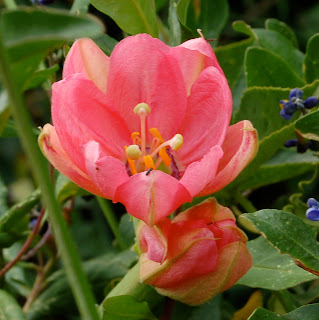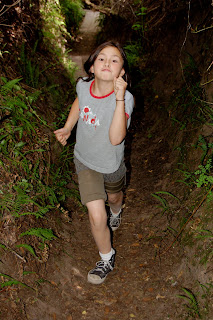
Green and Fertile in the Caldera
We were told that the Incas settled the crater, and later Dominican priests, but most impressive are the Yumbo tunnels, which are deeply eroded steep pathways embraced by thick underbrush. We rode horses through the tunnels running throughout the crater. Eric informed me that when riding horses, he spends every moment anticipating the end of the ride, so he worked on his computer in the groom' s house while Maya and I took our three hour ride. It was supposed to be four or five hours, but we trotted and cantered and galloped whenever it was possible and were back far too early. The day started hot and sunny and by the time we returned around 2 PM, the fog had rolled in and the temperature plummeted.


Maya on her Horse 'Brea'
Maya and Eric both decided that they wanted to buy a place and settle in this entrancing place, so close yet so far from the bustle of Quito. But driving in and out on the treacherous road ( the only way to drive) is too stressful for me. There is a walking path that local people take in and out of the crater, but it is incredibly steep and exhausting to climb, so it is not a reasonable option. Inhabitants are truly isolated in this magical escape from the world outside. Our guide lives in the crater, an hour or so by horse to and from work every day. She finds it peaceful and perfect for her at this point in her life, except that it feels a little creepy when the electricity is cut off for hours at a time.
More Clouds as we Leave Pululahua
Since we finished so early, we had time to visit Pucara Rumicucho, a massive Inca Fortress nearby in San Juan de Pichincha. I had seen it about six years ago, when it was difficult to find and poorly preserved. We struggled again to find it this time, but I have no problems asking for directions, so we found ourselves battling battering winds at the top of the fortress, with a commanding view to the north and the south.'Pucara' means fortress, 'rumi' means stone and 'cucho' means corner in Quichua, so all together it means Stone Fortress. It was built by the Inca invaders over a pre Incan structure. It was mostly a military outpost serving as an offensive and defensive guard post in their struggle to subjugate the resistant tribes of the north.


Rumicucho is built of five stone terraces in a pyramid shape, so there is a suggestion that it was also a gathering place to worship. The buildings align with the mountains in such a way that the sun crosses during the equinox, and of course the Incans were very much in tune with astronomy, so most of the places they chose to build were high with access to the stars and aligned in a way to capture the sun during the equinoxes and the solstices. My impression was that work had been done on the ruins since the last time I had visited. We did not stay for long because the wind threatened to carry us away. Most remarkable was the incredible views both north and south, and how incredibly dry the landscape was, so much in contrast to what we had seen at Pululahua.







 Riding in the Crater
Riding in the Crater




 Quitu Mortar and Pestle
Quitu Mortar and Pestle Maya Running Through Yumbo Trail
Maya Running Through Yumbo Trail







 Eucalyptis Trees
Eucalyptis Trees Labyrinth
Labyrinth
 Oiginal Wall
Oiginal Wall


 Sunflower in the Garden
Sunflower in the Garden Door on Calle San Marcos
Door on Calle San Marcos



 Ceiling in the Dining Hall
Ceiling in the Dining Hall

 Part of a Picture Frame
Part of a Picture Frame Famous Bolivar Theatre
Famous Bolivar Theatre
 Sunset
Sunset




 Painted Walls
Painted Walls

 Morning Mountain and Clouds
Morning Mountain and Clouds